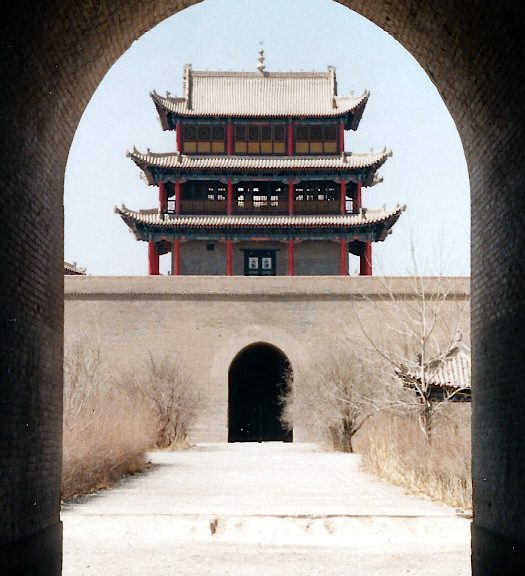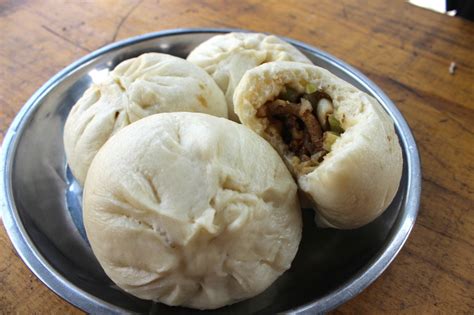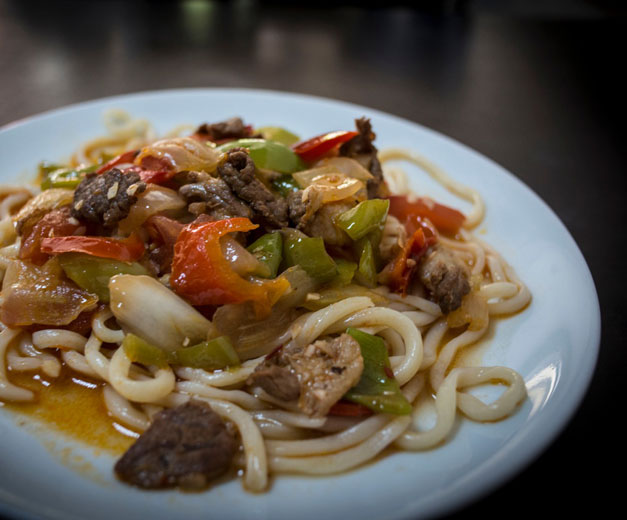
Between the desert and the mountains
13th April, Lanzhou. I decided that rather than go back to the train station, I would try a few travel agents to get my train ticket to Jiayuguan. After trying a few and a bit of bargaining I got a place on a train at 11.30am tomorrow, arriving at 6.15am the day after for 130 Y + 30Y commission. The times are pretty good and I get a bit of time to rest up after my exhausting time in Tibet. The food here was good as well. My diary notes that I had spicy kebabs and delicious Bao ze dumplings among other things.

In the morning I picked up my ticket and was surprised to get a 40Y refund! There was a huge queue at the station but they opened the gates at 11.20 and miraculously we were off on time at 11.35. The sleeping arrangements were a bit tight, 6 bunks per section and two stools by the window, through which you could see nothing. Of course my fellow passengers were chain smoking and spitting peanut shells and just spitting on the floor. I therefore spent most of my time in the dining car and had a few beers to while away the time.

I actually had a pretty good night’s sleep and we arrived on time in Jiayuguan just as it was starting to get light. I left the station in a minibus with the foreigners from the train and after getting refused at a couple of hotels I ended up sharing a room with an Aussie bloke at the Youth Hostel. He was in his 40s and worked as a clerk at an insurance company in Melbourne. However he managed to get a big holiday every year and had been everywhere – even more places than me – the TransSiberian, up and down South America, by bus from London to India, you name it.
Anyway, from the guide book: Jiāyùguān marks one of the defining points of the Silk Road. Following the construction of the Ming-dynasty fort here in 1372, Jiāyùguān came to be colloquially known as the ‘mouth’ of China, while the narrow Hexi Corridor, leading back towards the nèidì (inner lands), was dubbed the ‘throat’.
Even today the metaphor remains lodged in the Chinese psyche, and Jiāyùguān continues to mark the symbolic end of the Great Wall, the western gateway of China proper and, for imperial Chinese, the beginning of nowhere.
You’ll need plenty of imagination to conjure up visions of the Silk Road, as modern Jiāyùguān is a sprawling agglomeration of hideous industrial parks and belching smokestacks. Despite this, the Jiayuguan Fort is an essential part of Silk Road lore and definitely worth a visit.
We ended up hiring a taxi and went off to the Overhanging Great Wall. Believed to be first constructed in 1539, this reconstruction dates from 1987 and looked pretty new. From the top there were great views of the desert disappearing over the horizon in one direction and the Quilian range of mountains in the other. They looked eerie in the haze, just their snow peaks visible above the haze.



Then we drove on to the fort. Built in 1372, the fort was christened the ‘Impregnable Defile Under Heaven’. Although the Chinese often controlled territory far beyond the Jiāyùguān area, this was the last major stronghold of imperial China – the end of the ‘civilised world’, beyond which lay only desert demons and the barbarian armies of Central Asia. I can imagine in other times there would be hordes of tourists but presently there were only a dozen or so (Chinese). I noticed a few trying their hand at the tourist archery and having a camel ride.




Jiayuguan was a strange town. Very wide boulevards and tall statues at the intersections with grey, faceless buildings either side. Little activity on the street. A dozen or so food stalls and a little clothes market and a food market near the centre of town and that was it!
The following morning the motley crew of foreigners and a few Chinese I had seen on the train got in a minibus to Dunhuang. It turned out to be another arse numbing 7.5 hours along a bumpy desert tract. One bonus was that we stopped off half way for an enormous plate of delicious fried noodles. Eventually, in the shimmering distance I caught the welcoming glimpse of poplars indicating the Dunhuang oasis. Me and Ossie John booked in at the Feitan hotel and got quite a swish double for 50Y each – with bath! – but no hot water until 6pm. Therefore we had a wander around town enjoying some yak yoghurt and cold beer. We also browsed the night market but the prices for trinkets were ridiculously expensive. As we had travelled some distance west but were still on Beijing time it didn’t get dark until after 9pm, a little bit odd in April.


The following day the other foreigners got together again and went on a bus trip. I decided to get some exercise and so hired a bicycle for the day, intending to head out into the desert towards the Mogao caves. Energising myself on yoghurt and 3 eggs for breakfast I set off. I’m not sure whether I was really unfit or the bike was rubbish (probably a mixture of the two) but I was shattered by the time I got there. However, the desert scenery was wonderful and so silent, there was simply nothing to see but sand. I recharged with a drink and a plate of fried noodles ready to explore the caves.



The grottos were really impressive – apparently the greatest repository of Buddhist art in the world. It was quite spooky in places, small doors opened up to huge rooms covered in paintings. Photography wasn’t allowed and there wasn’t much light presumably to maintain their condition. One of the photos below is of the outside. Inside is huge buddha- over 30m tall apparently the third tallest in the world. A simply magical place.



The cycle back was OK, only 1.25 hours. I had a welcome beer in the cafe across the road from the hotel. It was really the only “traveller-type” place I’d seen on this trip – western-type menus, for instance with sandwiches on the menu but the execution of these treats was something else. Still it had tables outside and good to watch the streetlife.
The following day I was up and out by 8am. this time off to the dunes. My first moan about the Chinese. I stopped at some huge dunes just out of town and the bloke there charged me 1Y for parking my bike and then 6Y for visiting the dunes. Bizarre! Anyway, there were great views from the top and I was back in time for breakfast – pancakes and yoghurt.







I needed to get back as I wanted to press on. I took a bus to Liuyuan which was the railhead for my next stop – Turpan. Amazingly I went straight up to the ticket window and got a hard sleeper to Turpan straight away. The train arrived 30 minutes later and we were off. Not a very pleasant journey, my travelling companions were chainsmoking but also didn’t want the window open. It was boiling in here and I couldn’t breathe! Anyway, I slept OK and we arrived at Turpan at 5am, where there was a bus to take us into the city proper. The driver dropped me off in the middle of town. I was unsure of directions but managed to find the Turpan Guest House. From the picture below it looks like this hotel is no more. In fact I have been unable to find a lot of the hotels I stayed in on that trip, China has changed so much it would probably be unrecognisable to me today.

Turpan is a legendary oasis; its various settlements have long been a stopover on the northern route of the Silk Road. At 154m below sea level, it’s the third lowest depression in the world and the hottest spot in China – the highest recorded temperature here was 49.6°C!
Some streets here are pedestrian zones covered with grapevine trellis, a visual treat and a godsend in the fierce heat of summer.


I had a kip for a couple of hours then just had a wander around the bazaar and the town. I tried the famous Laghman noodles for lunch. Pretty good.

The tree lined backstreets were quite pleasant and I managed to find part of the ancient underground canal system – the karez. It was pretty delapidated I have to say. In the evening I went to the night market. It was quite small but I had some nan bread stuffed with kebabs. I didn’t go for the goat’s head soup but one of the stall holders enticed me to try some camel lung – yeuch!


The following day I got coerced into going on a guided trip with five Americans who were on a break after teaching English in Taiwan. 50Y for the day. We got picked up at 8am. It was actually a pretty good day. Plenty of fresh air, and pleasantly warm. My diary rather briefly mentions visiting a couple of ancient ruined cities. The first was Gaocheng. the guide book is a bit more****:
Originally settled in the 1st century BC, Gaochang (admission Y30) rose to power in the 7th century during the Tang dynasty. Also known as Khocho, or sometimes Kharakhoja, it became the Uighur capital in AD 850 and a major staging post on the Silk Road until it burned in the 14th century. Texts in classical Uighur, Sanskrit, Chinese and Tibetan have all been unearthed here, as well as evidence of a Nestorian church and a significant Manichean community – a dualistic Persian religion that borrowed figures from Christianity, Buddhism and Hinduism.
Though the earthen city walls, once 12m thick, are clearly visible, not much else at Gaochang ruins (Gāochāng Gùchéng) is in good condition other than a large Buddhist monastery in the southwest. To the north, adjacent to an adobe pagoda, is a two-storey structure (half underground), purportedly the ancient palace.
The second was Jiaohe, According to the guidebook: Also called Yarkhoto, Jiaohe (admission Y40) was established by the Chinese as a garrison town during the Han dynasty. It’s one of the world’s largest (6500 residents lived here), oldest and best-preserved ancient cities. If you only visit one desert city, make it this one: the buildings are more discernable than the ruins of Gaochang. A main road cuts through the city; at the end is a large monastery with Buddhist figures still visible. We also saw “Grape Valley”, the Emin minaret and the tombs of Astana. Two of the tombs were just holes in the ground, the third had two well preserved corpses. We also went to the Bezeklik Buddhist caves, attractively situated in the so called flaming mountains. these tombs are essentuially empty now, th emurals having been chiselled out of the rock face by German archaelogists in 1905.











A video from FarWest china:
Wed 21st April 1993. Had a bit of lie in and then got the bus for the fairly short 4 hour trip to Urumchi.

